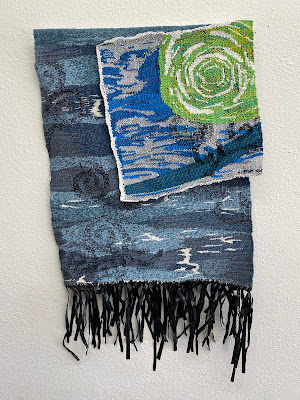The universe conspired to give me two extraordinary opportunities in the space of three weeks recently.
In March I took a weeklong class for beginners in painting landscapes with watercolors. This class was taught at Ghost Ranch, possibly my favorite place in the entire world, by accomplished watercolorist Patsy Welch. Since December, tendinitis in my shoulder had slowed my weaving and indeed all repetitive fiber work to a crawl, so I was desperate to experiment with other media.
As always, Ghost Ranch did not disappoint. Even in March, New Mexico's windiest and most unpredictable month, it was beautiful. We had snow and mud and cold; we also had sun and breathtaking displays of changing light across the buff and ochre mesas. And great clouds!
Patsy insisted that we use only the three primary colors and learn to mix all other colors from there. We practiced mixing, painting washes and textures and clouds, and we attempted landscapes. Several students were far from beginners and their work was inspiring and refined. As for me, well, you can take the weaver out of the studio but you can't take the weaver out of the artist. I could not get my mind around painting an actual landscape except for tiny studies--where does one start in all that vastness? Instead I made a collage, an artist's book of the small samples, and most intriguing to me, a tiny woven landscape.
A week after I returned from Ghost Ranch, I drove to Willowtail Springs, a nature preserve and education center near Mancos, Colorado. Months ago I'd applied for a one-week artist residency there and been accepted. It is a beautiful, quiet, wooded spot with the added bonus of a small lake and wonderful waterbirds I don't see or hear at home. I was the only artist in residence and had the use of the large, well-equipped studio all to myself.
 |
| The lake at Willowtail Springs |
 |
| The Garden Cottage where I stayed, a short walk from the studio below |
 |
| The studio at Willowtail. Look at all those work surfaces! The windows look out on the lake and I cracked them open so I could hear the birds and the burbling fountain outside as I worked. |
It was heaven. Hosts Peggy Cloy and Lee Cloy welcomed me warmly, showed me around, and then left me alone to work. The best part was simply the solitude, time and focus to really concentrate and follow the threads of a number of ideas that had been nudging me for awhile. It felt like an incredible luxury to be able to move from project to project at different worktables, to sit and read and work in my sketchbook, without having to dash off after an hour to an appointment or some other obligation.
One path I explored was paper weaving. Inspired by the work of @liesel.scribbles (Libby Raab) on Instagram, I experimented with weaving twill patterns with printed photos and watercolor paintings. This was really fun! I also discovered on IG the amazing paper weaving work of @galengibsoncornell (Galen Gibson-Cornell) and @miguel.arzabe (Miguel Arzabe). Check them out!
I worked my way through this fantastic new book: Art from Your Core by Kate Kretz. She is a professor of art, a painter and fiber artist as well. She has taught thousands of students, has an active practice as an exhibiting artist, and knows a thing or two (a LOT) about how to find one's way through the dark byways of one's own artistic psyche and in the world of art generally.* I can't recommend this book highly enough. It confirmed many things I had discovered on my own over the past three decades, but also provided long lists of questions and exercises to help me think through how my experience informs my voice at this point.
Another book that was helpful was Steven Aimone's Expressive Drawing. I had started working through his wonderful, approachable exercises in abstract drawing a couple times before, but this time I got farther along. I am intrigued by the possibilities of charcoal, of "asserting and obliterating" marks, lines and shapes, and of using charcoal and watercolor together. I'm looking forward to using these media to develop some of the motifs and themes that surfaced in my working through the Kretz book.
These are a couple of the quick expressive drawing/paintings I did based on the exercises in the Aimone book. These are not finished works but merely practice explorations in line, shape, texture and loosening up. So much fun!
Finally, the icing on the cake was that Rebecca Mezoff and Mary Fuller of Turquoise Raven gallery in Cortez, CO were among those who attending my closing talk. What fun to renew old connections and make new ones!
The residency at Willowtail couldn't have come at a better time for me. As regular readers know, for a few years now I've been testing the boundaries of tapestry with mixed media, relief, and small forays into three dimensions. My muse has been leading me in new directions. The week at Willowtail has given me confidence that I have many possible ways forward, that whether I am a weaver or not I am forever an artist (though one with a definite bias toward weaving and fibers!).
*One of my favorite bits was Kretz's distinction between the "art world" of museums, auction prices, and high-end commercial galleries, of trendy artists and art-as-investment, a world very few artists inhabit. . . and the "art life," which is what I, and I suspect most of us, lead. I had gotten these two things confused in my mind and caused myself way too much unnecessary angst.
























